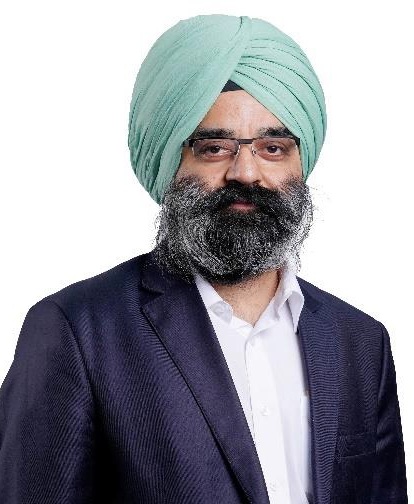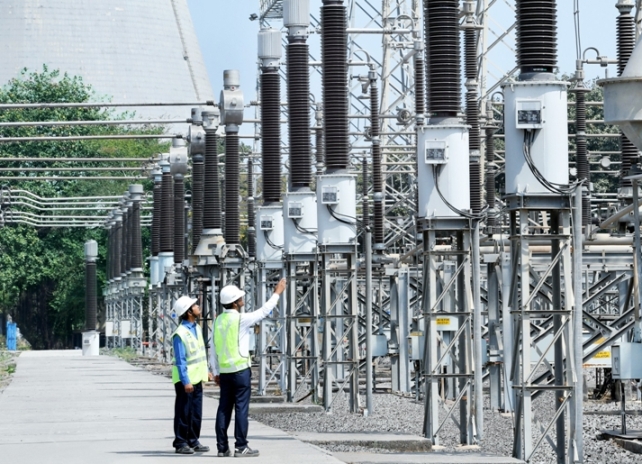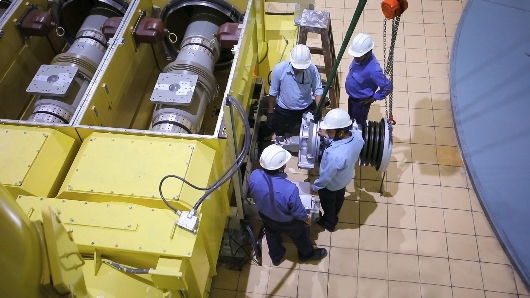

Hitachi ABB Power Grids represents the coming together of two prodigious names in the power transmission industry—Hitachi and ABB. In this exclusive joint interaction with T&D India, we have Thomas Westman, Head of High Voltage Service, Hitachi ABB Power Grids and Rupinder Singh, Head of High Voltage Products, Hitachi ABB Power Grids in India, discussing the evolving complexity that the Indian power grid faces, and how Hitachi ABB Power Grids is equipped to provide cost-effective and technically superior solutions to address the most pressing challenges. An interview by Venugopal Pillai.
The Indian power grid has been expanding at a rapid rate, especially over the past decade. In view of the sheer growing grid size, what challenges would grid management face?
Rupinder Singh: Electricity will soon become the backbone of the entire energy system. All market sectors from manufacturing to services will come to rely heavily on the grid which will integrate an ever-increasing share of distributed energy resources. Grid complexity will become a significant challenge. India is already one of the largest synchronous grids in the world. This necessitates the adoption of smart digital and energy solutions to manage the unpredictability associated with renewable energy and risks of grid instability. At the same time we need to look at our ageing infrastructure and find innovative solutions to extend the life of assets, upgrade and modernize to move towards digitalization.
By combining the strength of digital and energy platforms, we can manage the energy transition challenges, handle additional capacity and increased complexity, improve infrastructure utilization, facilitate predictive operations and maintenance, enable prognostics for planning, and reduce downtime.
How would the growing injection of renewable energy impact grid stability? What are the competent solutions?
Rupinder Singh: A strong grid is able to maximise the integration of renewables. In order to add large volumes of renewables to the grid without affecting its stability, we must first fortify it. The unpredictable nature of renewable energy makes forecasting of renewable power generation challenging. Today, we are also introducing highly interconnected technologies like microgrid and solar power, which add further complexities of maintaining a stable regional and national grid.
Thomas Westman: The renewable segment demands different service capabilities than a traditional utility. The focus is on ensuring availability of assets. This means operators are looking for proactive operation and maintenance solutions that provide a higher return on investment. Equally important, response time for troubleshooting has to be rapid, coupled with availability of service experts and spares. Today, more than ever, it is important to invest in technologies that can provide remote assistance and monitoring of assets as well as trainings for operators.
“By combining the strength of digital and energy platforms, we can manage the energy transition challenges.”
Hitachi ABB Power Grids represents the coming together of two big names in the power transmission industry. Please discuss how this union will help improve the individual portfolio of power transmission products and services, of the two companies?
Thomas Westman: The joint venture brought together two iconic companies to create a new global leader in the power sector with a sizeable and complementary presence across global markets. Hitachi’s leading digital technologies, combined with world-class power grids solutions, will help us actively support the global transformation and decarbonisation of the energy system. The alliance will facilitate growth opportunities for the new entity in areas such as mobility, smart cities, industry, energy storage and data centres. Combining our respective technology strengths will bring us new market opportunities and enable us to deliver greater customer value. For the global organisation, it opens up new geographies, most notably Japan, the third largest economy in the world. It will grow our service portfolio offering for existing and new customers.
When we speak of the “high voltage service” of Hitachi ABB Power Grids, what products and services does this broadly encompass?
 Thomas Westman: Our high-voltage service strategies are developed to suit different requirements ranging from installation, maintenance, overhauls, retrofits and upgrades to decommissioning. Through a robust product lifecycle management, Hitachi ABB Power Grids defines availability of services during each phase of the product lifecycle: active, classic and limited. As a result, customers benefit from higher reliability, safety and improved maintenance of assets. We offer long-term service agreements that are tailored to enhance customer values like install and commission, train and develop, assess and advise, maintain and sustain, upgrade and replace.
Thomas Westman: Our high-voltage service strategies are developed to suit different requirements ranging from installation, maintenance, overhauls, retrofits and upgrades to decommissioning. Through a robust product lifecycle management, Hitachi ABB Power Grids defines availability of services during each phase of the product lifecycle: active, classic and limited. As a result, customers benefit from higher reliability, safety and improved maintenance of assets. We offer long-term service agreements that are tailored to enhance customer values like install and commission, train and develop, assess and advise, maintain and sustain, upgrade and replace.
Rupinder Singh: Our greatest strength is ability to combine local knowledge and competence with global expertise and resources. Our local service centers can leverage the expertise of the global service organization to collaboratively support the customer’s need, at site or virtually. In case of remote support, we employ cutting edge tools that leverage technologies such as augmented reality for technical assistance on site. Our global state-of-the-art Collaboration Centers offer the same capabilities and expertise that our customers expect of typical onsite service, now available remotely and on-demand.
“Today, more than ever, it is important to invest in technologies that can provide remote assistance and monitoring of assets as well as trainings for operators.”
Even as the Indian power grid continues to expand with new transmission lines, substations, etc, there is growing consciousness for adopting “green” measures. Please discuss.
Rupinder Singh: The path towards carbon-neutrality has one common denominator: it is built on much more electrification. That can be achieved via three key building blocks: One; accelerated shift from fossil-based towards renewable power generation. Two; growing electrification of transportation (such as for EVs), of industry (for process conversion), and of buildings (for cooling), and three; sustainable energy carriers.
Sustainable energy carriers are relevant where direct electrification is not possible or not the most efficient way. For example, in aviation or large ships, we need to look to other sustainable and complementary energy carriers (e.g. green hydrogen, which is a form of indirect electrification). To make the grid stronger, smarter and greener, we have to deploy intelligent technologies and service support across all key sectors — utilities, transport and infrastructure and industry. We need them to support renewables integration in the grid, bring power to all, and maintain the resilience and longevity of mission-critical assets such as high voltage transmission lines and substations. This is crucial to support our clean energy transition.
“To make the grid stronger, smarter and greener, we have to deploy intelligent technologies and service support across all key sectors — utilities, transport and infrastructure and industry.”
What is your view on the recent discussions about replacing “SF₆” (which is believed to be a greenhouse gas) by an eco-efficient gas?
Thomas Westman: Our world needs to deliver upon urgent climate change commitments and circular economy. As society shifts towards sustainable energy and as industries rapidly convert to electrification, there is greater consciousness towards carbon neutrality.
 For almost half a century, SF₆ has been the norm in the electrical industry due to its excellent insulation and switching capabilities. However, it has high Global Warming Potential (GWP) if leaked. Hitachi ABB Power Grids is continuously reducing the use of SF₆, improving its lifecycle management, and accelerating the development of eco-efficient products and solutions as alternative to SF₆. We have been investing in eco-efficient alternative solutions as part of our commitment to reduce environmental impact. Following more than two decades of intensive R&D, and since 2010, Hitachi ABB Power Grids has been deploying eco-efficient alternatives to SF₆. For example, we pioneered world’s first high-voltage eco-efficient switchgear as alternative to SF₆ to reduce environmental impact.
For almost half a century, SF₆ has been the norm in the electrical industry due to its excellent insulation and switching capabilities. However, it has high Global Warming Potential (GWP) if leaked. Hitachi ABB Power Grids is continuously reducing the use of SF₆, improving its lifecycle management, and accelerating the development of eco-efficient products and solutions as alternative to SF₆. We have been investing in eco-efficient alternative solutions as part of our commitment to reduce environmental impact. Following more than two decades of intensive R&D, and since 2010, Hitachi ABB Power Grids has been deploying eco-efficient alternatives to SF₆. For example, we pioneered world’s first high-voltage eco-efficient switchgear as alternative to SF₆ to reduce environmental impact.
In April 2021, we launched the first part of our new EconiQ™ eco-efficient portfolio for sustainability where products, services and solutions are proven to deliver exceptional environmental performance. Our game-changing technology using fluoronitrile-based gas mixtures as an alternative to SF₆ in high-voltage equipment will pave the way for a new global industry standard. This unlocks the acceleration of eco-efficient alternatives to SF₆ in the industry, which will support the widest range of applications in switchgear than ever before.
“Simply replacing ageing assets is an economically unviable option.”
Coming back to the Indian grid, there is also a concern of replacing ageing infrastructure. What challenges does this present?
Rupinder Singh: There has been tremendous growth in the power sector in India in last 20 years. From the asset owner’s perspective, while new technologically-advanced assets need to be added, ageing assets need lifecycle services like maintenance, retrofit, and upgrade to ensure they continue to operate efficiently.
Aged installed base makes a significant portion of the total assets owned by utilities or industries, as typical life cycle of high-voltage products is more than 30 years. Simply replacing ageing assets is an economically unviable option. It poses challenges like availability of equipment in the market, lead times and service disruptions. It needs careful planning and a clever mix of investments that give new life and modernize aging assets, as well as allow newer opportunity to add new assets with latest technologies.
Digitization and integration of legacy assets into smart grid is a challenge but with the plethora of solutions available with us we can easily convert a conventional grid into a smart grid. We have implemented several projects, where aging assets have been modernised cost effectively. Such tailor-made solutions also ensure availability of spare parts and competent field technicians for service.
Please discuss some recent projects deploying the High Voltage Services of Hitachi ABB Power Grids in India.
 Rupinder Singh: Hitachi ABB Power Grids offers its full spectrum of high-voltage services for brownfield and greenfield projects in India. Our services are supporting customers in enhancing long-term equipment reliability while minimizing the environmental impact. Some of our recent projects include installation of strategic spares in pumped storage power plant in West Bengal. Timely availability of these components reduced the maintenance period for the power plant, ensuring continuous and reliable power supply to more than 1.8 million Indian homes.
Rupinder Singh: Hitachi ABB Power Grids offers its full spectrum of high-voltage services for brownfield and greenfield projects in India. Our services are supporting customers in enhancing long-term equipment reliability while minimizing the environmental impact. Some of our recent projects include installation of strategic spares in pumped storage power plant in West Bengal. Timely availability of these components reduced the maintenance period for the power plant, ensuring continuous and reliable power supply to more than 1.8 million Indian homes.
Another interesting project was a tailor-made disconnector retrofit solution implemented for the customer, in one-fifth the time of a standard solution, in Gujarat. The solution ensured trouble-free and efficient operations for the plant, avoiding costly infrastructure investment. Thanks to the successful completion, the utility will implement similar solution in its other substations as well.
During the lockdown period, we aimed to ensure business continuity for our customers. One interesting case was through remote support by leveraging digital technologies. We delivered fast and efficient service that ensured availability of critical high-voltage assets for a substation in Punjab. From more than 1,200 km away, through real-time collaboration and remote services, our field service experts repaired and restored circuit breakers to their optimal performance, improving the overall reliability of the substation.
“We will continue to strengthen our digital service capabilities to bring our global expertise and experience to India.”
Given India’s continuing thrust on power transmission, and the increasing role of private sector developers, how do you see business opportunities in the years to come?
Rupinder Singh: In this difficult time, our immediate priorities are to protect our people, preserve business continuity and prepare for the new norm. As normalcy returns, we see the government’s push for infrastructure development under ‘Make in India’ lending support for industry growth.
We see ourselves growing in a number of strategically selected high-growth segments, such as renewables, green energy corridor transmission, rail electrification and metro, data centers, grid digitalization, and smart sector integration (e-mobility), among others. We will continue to make in India for India and for the rest of the world. Our products, services and systems today reach more than 75 countries.
We have the largest installed base in the country. To support this installed base, we continue to focus on developing the right talent pool of service experts and leverage our competence and technologies through Service Level Agreements.
Thomas Westman: We will continue to strengthen our digital service capabilities to bring our global expertise and experience to India. As an example of that we set up a state-of-the-art remote monitoring and reliability service center – PowerREC – in Bangalore in the beginning of this year. The center will offer our customers an advanced maintenance platform to improve the overall reliability and up-time of their power assets.
Industrial images in this interview, representing projects/assets of Hitachi Power Grids, have been used for illustration only.


